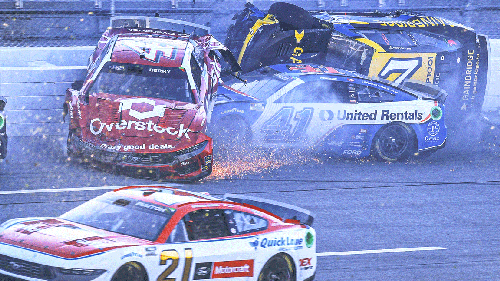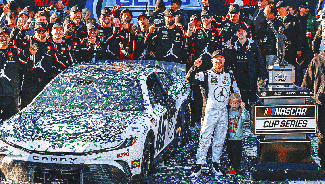
Is NASCAR's Next Gen car safe? Some drivers have questions
By Bob Pockrass
FOX Sports NASCAR Writer
HAMPTON, Ga. – NASCAR has tried for months to quietly squelch rumors of potential issues regarding the safety of its Next Gen car set to debut next season.
There was nothing quiet about the topic over the last four days.
After Chase Briscoe made a social media post confirming that there were rumors of NASCAR data from crash test dummies indicating potential for fatal accidents with the car, NASCAR went public with a little information and drivers sounded off.
Looking for more NASCAR content? Sign up for the FOX Sports NASCAR Newsletter with Bob Pockrass!
The drivers are coming from a place of a lack of knowledge of the results of NASCAR safety testing as opposed to the actual results of the testing.
NASCAR had said its simulations of accidents with the new car didn’t show any concerns, which they told the drivers in May after they began voicing concerns.
After a delay in an actual crash test, NASCAR finally did one June 30 at Talladega Superspeedway, where NASCAR had a robotically controlled car slam into a wall.
Briscoe’s post on Thursday was a little bit of a surprise to NASCAR, which four days earlier – on the morning of the Road America race – had sent a message to a chat thread it has with drivers indicating that its initial data has shown that everything worked as expected.
"Preliminary review of the dummy data from the test indicates good and comparable performance when compared to other right-front dummy data," the memo said.
"There is still a lot more analysis to be completed and that has started.
"Worth noting, that through all testing (sled and full vehicle) the dummy itself has functioned nominally."
NASCAR’s consultants – four doctors they often use to evaluate changes when it comes to safety – will evaluate the crash test data and issue a report. Once NASCAR gets that report and the OK from the consultants, NASCAR will begin distributing the chassis to the teams – teams no longer will be building chassis but will instead get them from a single supplier.
Teams can’t start assembling the cars until they get the chassis. And they feel they are behind.
It all has led to incredible angst. Ryan Blaney said at one point he was told that there was a failure at a test, but it actually was a failure of the testing apparatus, not the car nor the results.
NASCAR has a solid safety record but also has had times where its predictions as far as car speeds or how cars will race have not been spot-on.
So it makes sense that the drivers and the teams want data.
"Seeing NASCAR’s presentation [in May] and the things that they’ve done with the car is very impressive and the data and all the things that go with that is very impressive and how they lay the crashes out in the simulation that they have," said veteran Cup driver Kevin Harvick.
"I think it’s just when the drivers were a part of the process is why everybody is a little frustrated with that, and, here we are, we’re supposed to go to Bristol in a month with our car to do a tire test and can’t get chassis."
NASCAR officials indicated that the memo they sent to drivers on Sunday encouraged them to find NASCAR officials and ask questions. They said only one did.
Brad Keselowski said he has looked at the chassis but does not have enough information to know about the potential for injury in the car. He said Penske’s safety division has not told him of any issues.
"No one there has raised any red flags, which I guess is probably part of my confidence, but, then again, they don’t have a car, either, on-site," Keselowski said. "I just don’t know if there’s enough information right now.
"We’re still in July. It’s not like we’re starting the season. It’s not like we’re in Daytona, but that said, we do have some key tests and moments coming up, but I think we should let those play out a little bit before getting too excited."
But it is hard for some drives not to get excited. They, after all, are the ones strapping themselves inside the car and putting their lives on the line.
Some deep skepticism is not necessarily a bad thing when trying to make sure everything is safe. While the car does have foam in the front and rear bumpers, the main concern appears to be a right front impact with the wall, and whether the car will crush and absorb energy. If it doesn’t absorb energy, the driver will.
"I said to NASCAR, ‘In no aspect, in no angle should it ever be worse than what we’re currently racing because we don’t want injuries to be part of our sport,’" said veteran driver Denny Hamlin.
"Ultimately, you really want to mess this thing up, start having a bunch of concussion injuries and broken bones, this thing can go downhill pretty quick. I think they’ll be pretty smart in making sure that the data supports and it’s a car they feel comfortable putting themselves in for the drivers."
Hamlin is among those who have heard too many rumors to feel comfortable at this point.
"Simulation, while very, very good is still not the real thing," Hamlin said. "We were eagerly awaiting what the results were going to be from the June 30 test. ... I guess there’s rumors that start from people that are kind of close to it and it doesn’t sound great, but again, there’s no hard data.
"I would assume if things went fantastic, we would have heard about it pretty soon."
If NASCAR’s consultants give the car the green light, Hamlin said he would be good with it. At least one of the consultants worked on the report of Dale Earnhardt’s fatal crash in the 2001 Daytona 500 – the last fatality in a NASCAR national series race.
As Harvick noted, most drivers wouldn’t know the consultant who worked on a report 20 years ago.
"It’s our butts in the car and our heads in the car," said Penske driver Joey Logano. "The car looks strong … which is good in a lot of ways, but in other ways you’ve got to have some crush zones, so I think we’re all curious to see what the numbers come back at."
For more up-to-date news on all things NASCAR, click here to register for alerts on the FOX Sports app!
Thinking Out Loud
Ross Chastain did what teammates typically do as he took Kyle Busch’s line away from him to avoid being lapped on Sunday – stalling Busch in traffic and allowing Chastain’s Chip Ganassi Racing teammate Kurt Busch to catch Kyle and eventually pass him for the lead.
Certainly, Kyle Busch was going to be mad. But that’s one of the reasons to have multiple cars. And Joe Gibbs Racing drivers probably would have done the same for each other.
As long as neither Kurt Busch nor Chastain complain when the favor is returned, then this wasn’t the worst act of teammate help. It is kind of the unfortunate reality of racing when there are teammates. And even if they weren’t teammates, it is something that drivers will do for another if they want to reciprocate an earlier favor.
It is nothing that NASCAR has to get involved with. If there are issues, they will be taken care of when Chastain or Kurt Busch will want a favor from Kyle. Not going to happen.
Social Spotlight
Stat of Note
Kurt Busch’s victory at Atlanta was the first Atlanta victory for Chip Ganassi Racing.
They Said It
"He did stop by Victory Lane and do the Kyle Busch grumpy. That's what I expected." – Kurt Busch on his brother, Kyle, congratulating him Sunday
Bob Pockrass has spent decades covering motorsports, including the past 30 Daytona 500s. He joined FOX Sports in 2019 following stints at ESPN, Sporting News, NASCAR Scene magazine and The (Daytona Beach) News-Journal. Follow him on Twitter and Instagram @bobpockrass.
Looking for more NASCAR content? Sign up for the FOX Sports NASCAR Newsletter with Bob Pockrass!










































































































































